 Facebook
Facebook
 X
X
 Instagram
Instagram
 TikTok
TikTok
 Youtube
Youtube
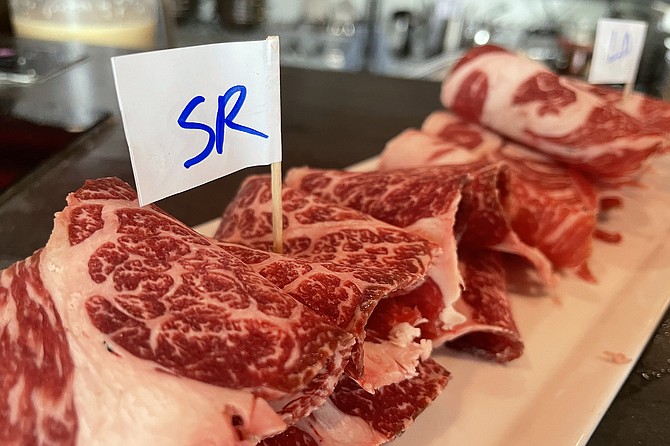
This is a story I meant to write over a year ago, before I owned any masks. That’s roughly the time Tabu Shabu opened up in the North Park property that was the long, long time home of Paesano’s Italian restaurant.
The place could not look more different these days: gone is the “since 1967” green awning out front, and the homey “we love italy” interior. Now, the storefront is covered with a smart wood veneer, and rather than booths and tables, the modernized interior has been given over to a long, U-shaped bar, each seat equipped with an electric, tabletop hot plate.
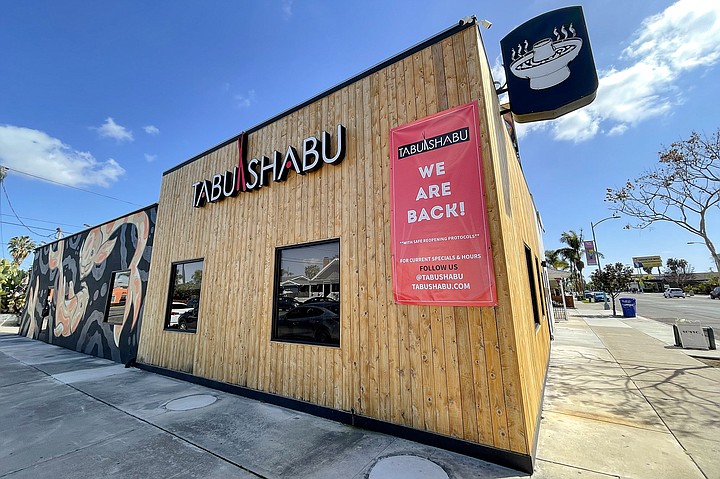
It’s a fairly slick setup for shabu shabu, the more fun to say term referring to Japanese hot pot. The name translates to “swish swish,” the premise being that each diner swishes a thinly sliced piece of meat into boiling broth to cook it. That cooking takes anywhere from 10 to 45 seconds, and means that, kind of like tabletop barbecue, you wind up eating hot, freshly cooked everything.
I put off writing about Tabu Shabu mainly because visiting involves things that haven’t been altogether enticing over the past year, such as eating indoors, sitting at a bar, and cooking alongside other people. To its credit, the restaurant has muscled through the pandemic and even offers take-out shabu shabu packages for families willing to hot pot at home. But part of the fun here is cooking at your seat, and it didn’t seem to me that standing around the kitchen stove, using chopsticks to pluck at hot slices of boiled ribeye, truly captured the experience.
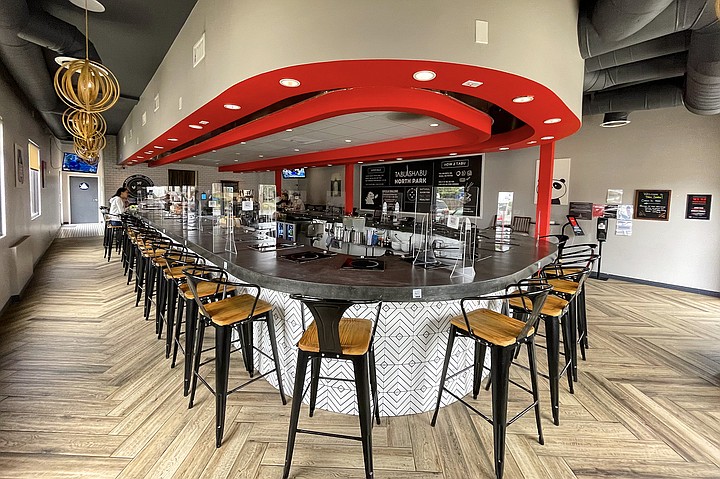
Tabu Shabu started in Costa Mesa back in 2012 and has been slowly expanding with franchises throughout Southern California, including a location in Carlsbad. I’ve been eager to try it all these fifteen months. So, fully vaccinated and bundled up against yet another late spring cold snap, we arrived as it opened to secure a pair of seats at the bar. Plexiglass shields on either side separated us from what turned out to be a full house — within minutes of opening, every seat was taken. Apparently, North Park has been craving a bit of swish swish.
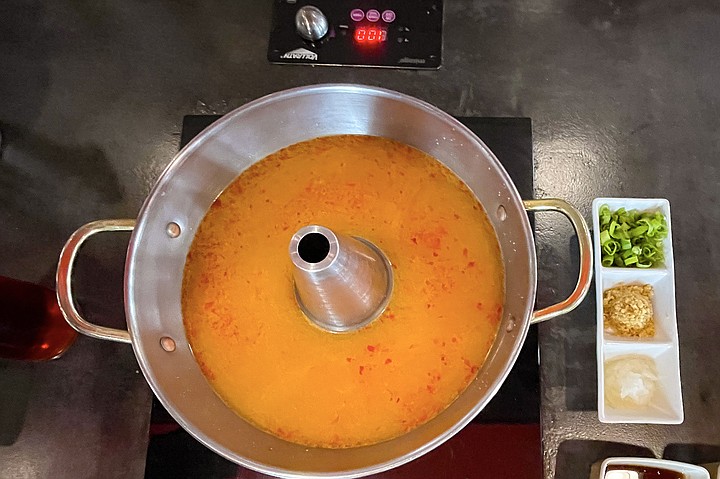
It’s not hard to tell why. Tabu Shabu delivers on its promise of quality meats, forcing us to choose between the likes of grass fed ribeye, prime ribeye, and wagyu short rib. Meals are priced based on which protein you choose, and how much. So, a 4-ounce “regular” serving ranges from $18-24, a 6-ounce large from $25-30, and it actually goes up from there. For $32, you can get a large portion split between two different proteins, so my wife chose prime ribeye and scallops, while I went with that wagyu short rib and lamb.
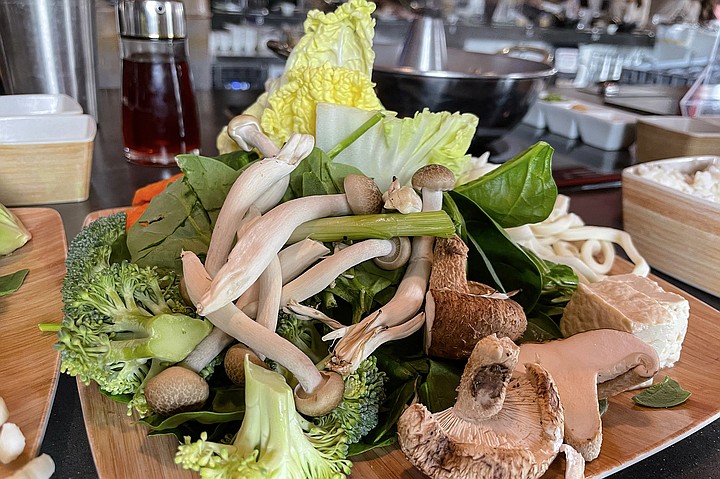
Whichever size you select, you’ll get a plate of mushrooms, tofu, vegetables, and udon noodles to go with your meat, as well as dipping sauces of ponzu and goma (sesame dressing). There are also flavorings to add to your boiling broth, including fish sauce, chili-sesame oil, and a chili-garlic sauce akin to sriracha. My favorite add-on though, has to be capsaicin drops. Capsaicin is the spicy component of chili peppers, also known as the active ingredient of pepper spray. In fact, our server explained the capsaicin drops can only be added to the dipping sauces, because if we put it in boiling broth, the resulting steam could make everyone in the restaurant cry.
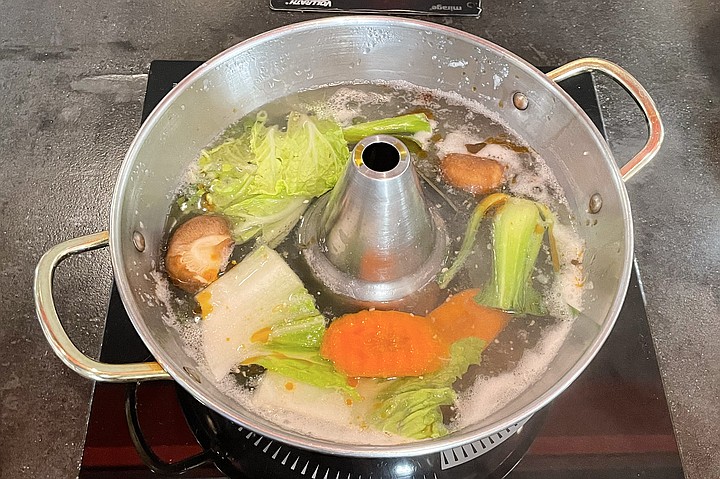
There’s one more personalization to consider, and that’s the broth itself. I opted for the more traditional shabu broth: kombu dashi, made from seaweed and water. There’s a pleasant umami to dashi, though I’m betting most American palates will prefer a less subtle flavor. My wife chose spicy miso, which is an easy, likeable bet. Upgrades will get pork bone broth tonkotsu (+$1) or sukiyaki, a sweetened soy broth based on another Japanese tabletop cooking tradition.
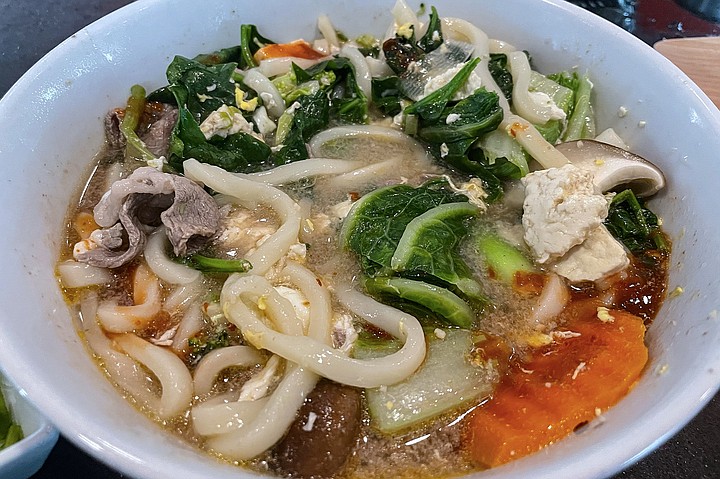
Regardless which broth you choose, fat melting off those slices of meat will richen it. Early in the meal, you swish your meat and vegetables, then dip, or lay it over a bowl of rice to eat. But one of the cool things about shabu shabu is you can sort of watch a bowl of soup develop. After the stock thickens a bit, it’s time to add those noodles, plus whatever ingredients you have remaining, to yield a meat and vegetable udon soup.
It’s quite a fun experience, best accompanied by a couple rounds of beer, and I can’t think of any reason to wait a moment longer.


This is a story I meant to write over a year ago, before I owned any masks. That’s roughly the time Tabu Shabu opened up in the North Park property that was the long, long time home of Paesano’s Italian restaurant.
The place could not look more different these days: gone is the “since 1967” green awning out front, and the homey “we love italy” interior. Now, the storefront is covered with a smart wood veneer, and rather than booths and tables, the modernized interior has been given over to a long, U-shaped bar, each seat equipped with an electric, tabletop hot plate.

It’s a fairly slick setup for shabu shabu, the more fun to say term referring to Japanese hot pot. The name translates to “swish swish,” the premise being that each diner swishes a thinly sliced piece of meat into boiling broth to cook it. That cooking takes anywhere from 10 to 45 seconds, and means that, kind of like tabletop barbecue, you wind up eating hot, freshly cooked everything.
I put off writing about Tabu Shabu mainly because visiting involves things that haven’t been altogether enticing over the past year, such as eating indoors, sitting at a bar, and cooking alongside other people. To its credit, the restaurant has muscled through the pandemic and even offers take-out shabu shabu packages for families willing to hot pot at home. But part of the fun here is cooking at your seat, and it didn’t seem to me that standing around the kitchen stove, using chopsticks to pluck at hot slices of boiled ribeye, truly captured the experience.

Tabu Shabu started in Costa Mesa back in 2012 and has been slowly expanding with franchises throughout Southern California, including a location in Carlsbad. I’ve been eager to try it all these fifteen months. So, fully vaccinated and bundled up against yet another late spring cold snap, we arrived as it opened to secure a pair of seats at the bar. Plexiglass shields on either side separated us from what turned out to be a full house — within minutes of opening, every seat was taken. Apparently, North Park has been craving a bit of swish swish.

It’s not hard to tell why. Tabu Shabu delivers on its promise of quality meats, forcing us to choose between the likes of grass fed ribeye, prime ribeye, and wagyu short rib. Meals are priced based on which protein you choose, and how much. So, a 4-ounce “regular” serving ranges from $18-24, a 6-ounce large from $25-30, and it actually goes up from there. For $32, you can get a large portion split between two different proteins, so my wife chose prime ribeye and scallops, while I went with that wagyu short rib and lamb.

Whichever size you select, you’ll get a plate of mushrooms, tofu, vegetables, and udon noodles to go with your meat, as well as dipping sauces of ponzu and goma (sesame dressing). There are also flavorings to add to your boiling broth, including fish sauce, chili-sesame oil, and a chili-garlic sauce akin to sriracha. My favorite add-on though, has to be capsaicin drops. Capsaicin is the spicy component of chili peppers, also known as the active ingredient of pepper spray. In fact, our server explained the capsaicin drops can only be added to the dipping sauces, because if we put it in boiling broth, the resulting steam could make everyone in the restaurant cry.

There’s one more personalization to consider, and that’s the broth itself. I opted for the more traditional shabu broth: kombu dashi, made from seaweed and water. There’s a pleasant umami to dashi, though I’m betting most American palates will prefer a less subtle flavor. My wife chose spicy miso, which is an easy, likeable bet. Upgrades will get pork bone broth tonkotsu (+$1) or sukiyaki, a sweetened soy broth based on another Japanese tabletop cooking tradition.

Regardless which broth you choose, fat melting off those slices of meat will richen it. Early in the meal, you swish your meat and vegetables, then dip, or lay it over a bowl of rice to eat. But one of the cool things about shabu shabu is you can sort of watch a bowl of soup develop. After the stock thickens a bit, it’s time to add those noodles, plus whatever ingredients you have remaining, to yield a meat and vegetable udon soup.
It’s quite a fun experience, best accompanied by a couple rounds of beer, and I can’t think of any reason to wait a moment longer.
Comments